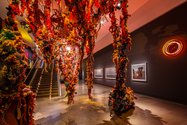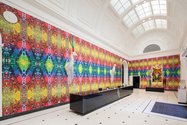Carmen Ansaldo – 29 April, 2016
Because of its history and associated themes of noble savagery, orientalism and imperial dominance, the Wunderkammer is a method of curation long since dead and buried. However, Magic Object has dug up the concept (conveniently overlooking the blatant historical problematics of doing so) to use it as a lens through which the viewer is to consider the works of contemporary Australian artists.
Adelaide
Group exhibition
Magic Object
25 February - 15 May 2016
Magic Object - the 2016 Adelaide Biennial of Australian Art - aims to reconceptualise the practices of 25 contemporary Australian artists as varying forms of esoteric craft, repositioning each artist within the role of a magician. Magic Object has expressed this repositioning through the Renaissance display method of the Wunderkammer or ‘cabinet of curiosities’, a system originally devised to exhibit the imperialist artefact collections of English, German and Dutch royalty some five hundred years ago.
The objects displayed within these cabinets were regarded by their imperialist ‘collectors’ as magic in the most vulgar sense of the word, as the objects on display were often pillaged from their Indigenous owners and ripped from their original contexts, meanings and usages. This de-contextualisation was integral if they were to fulfil their new role of appeasing the fascination, novelty and ethnographic hypotheses of the white European elite. Because of this history and its associated themes of noble savagery, orientalism and imperial dominance, the Wunderkammer is a method of curation long since dead and buried. However, Magic Object has dug up the concept (conveniently overlooking the blatant historical problematics of doing so) to use it as a lens through which the viewer is to consider the works of contemporary Australian artists.
Stretching over five sites, Magic Object‘s stronger works are located at the Anne and Gordon Samstag Museum of Art, which coincidently houses the majority of the younger artists selected (although impressively, the ages represented within the Biennial range from 27 to 105 years old).
Clare Milledge’s marrying of European folk art techniques to her own contemporary sensibility is of particular note. Milledge harnesses Hinterglasmalerei (a German technique whereby the artist works up painted layers onto the back of a pane of glass to build an image) in combination with draped layers of clashing textiles to create hung sculptural forms of exceptional compositional sensibility. Magic Object‘s curatorial focus on other forms of craft, object and folk art-most notably ceramic works and stoneware-means that Magic Object‘s selection isn’t simply a roll call of the usual suspects from the national art scene.
Pintupi/Lunitija artist Pepai Jangala Carroll is a particularly welcome inclusion, owing to the fact that his ceramic vessels clearly warrant representation in a national survey of art but have been regrettably overlooked until recent years due to their longstanding classification as craft. The ongoing focus on object-based art also yielded the Biennial’s strongest inclusion: Lola Greeno’s solo exhibition at the JamFactory site. Such a large display of Greeno’s wearable (and unwearable) jewellery objects of mussel, scallop, abalone shells and echidna quills has not previously been exhibited. Greeno’s artistic concerns broach tradition and family structures, ritual, environmental conservation and site-specificity. Imaginative and technically involved, Greeno’s jewellery shifts significance depending on whom it adorns and for what purpose.
Unfortunately, the impressiveness of Greeno’s inclusion into Magic Object is overshadowed by the Biennial’s insistence on stuffing her concepts into the logic of the Wunderkammer theme. Specifically, Magic Object frames Greeno’s pieces as a ‘tribute’ to the 1720 Dutch conchological society and its leader, Henry E. Coomans. This ‘tribute’ becomes problematic when we contextualise it within Greeno’s position as a First Nations artist practising within the European legacy of colonial invasion. The objects of Indigenous peoples have been relegated to the Wunderkammer historically, and we now witness this tendency occurring once again.
Magic Object‘s unwillingness to engage with the historical (or political) stakes of its curatorial theme results in its best exhibits becoming the most problematic for its premise. When a theme must be gutted of historical context in order to function, it can only encourage an equally gutted reading of the intentions behind the works it encompasses. Any overarching theme that requires its artists to de-contextualise their practice and concerns in order to participate misses the point of what makes such large-scale group exhibitions interesting or relevant to the art-going public today.
Many of the concepts engaging contemporary artists today are of such enormity and complexity that to disregard their gravity in favour of re-interpreting them as a mixed bag of ‘magical’ processes appears outright escapist. It is this drainage of the works’ intended meaning that has created a strange effect wherein a presentation of otherwise resolved artists across a broad spectrum of mediums appears unchallenging and childish. Magic Object made a conscious effort to represent artists from diverse backgrounds within the Australian population, yet the works that stand out are those that assert their individual integrity by actively fighting against their curatorial reframing as ‘magic’.
While Magic Object includes an impressive selection of artists whose practices reaffirm the uniqueness of Australian contemporary art, it falls short of affirming its selection by mobilising a curatorial theme whose imperialist and racist foundations are far better left buried in the graveyards of antiquated thought. Let’s see more exhibitions that address what it means to live and breathe in Australia in the year 2016 rather than Germany in the 1500s. This is not to deny the existence of large swathes of the white Australian population who would enthusiastically support such an ideological retreat, but let’s not have that desire embedded within our major art institutions (at least not anymore).
Carmen Anseldo






 Advertising in this column
Advertising in this column Two Rooms presents a program of residencies and projects
Two Rooms presents a program of residencies and projects



This Discussion has 0 comments.
Comment
Participate
Register to Participate.
Sign in
Sign in to an existing account.